![]()
Index | Pottery | Pottery manufacturers |
|
Spode Ltd |
|
|
[Josiah
Spode] |
[Copeland
& Garrett] |
[W.
T. Copeland (& Sons)] |
[Spode
Ltd] |
Location and period of operation:
|
Spode
Ltd |
Stoke |
1970 |
active 2025 |
| Earthenware,
bone china
manufacturer at the Spode Works, Stoke,
Stoke-on-Trent, England
The period from about 1966–2008 is described by the Spode Museum Trust as one of repeated ownership changes and
reorganisations. Carborundum Co. Ltd 1966-78
Royal Worcester Spode Ltd 1978-2007
Portmeirion Potteries 2009-
|
Previously: W. T. Copeland & Sons
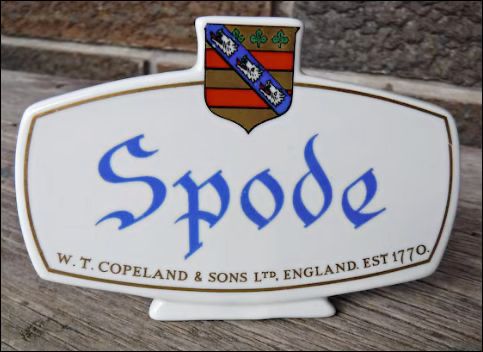
Spode
W. T. Copeland & Sons Ltd. England. Est 1770
advertising
display sign - typeface used for the Spode name is derived
from that used on Felspar Porcelain marks introduced in 1821
the arms are related to the Copeland family
photo acknowledgment: online market place etsy.com
Spode Ltd
Marks 1970 - 2009
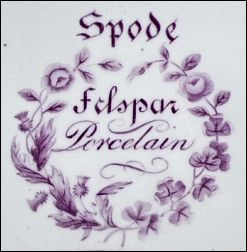
Spode |
Made in England
|
England
|
|
In 1970 the name was changed from W. T. Copeland & Sons to Spode Ltd as a branding move to reflect 200 years of the business started by Josiah Spode I in 1770. "The designer, John Sutherland-Hawes, was commissioned to produce a new logo to mark the bicentenary of the company in 1970... His brief was to present a uniform image of excellence. Taking inspiration from the early 19th century red painted Spode marks plus later printed adaptations he produced the 'Gothic' style logo in red which became world famous." Spode History |
|
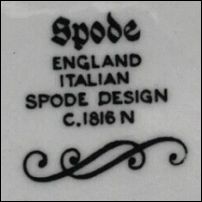 |
This
mark incorporates a letter 'C' in a square seal. |
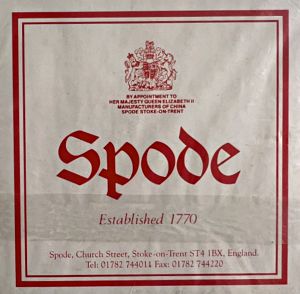
Spode
packaging incorporating the Royal Arms 'by appointment' to HM Queen
Elizabeth II |
|
For comparison - original crown and laurel mark introduced by Copeland & Garrett 1833-1847 |
|
|
this mark without "Made in England" shows that the ware was made in the Far East. |
|
Around 1997 Spode Ltd introduced a reproduction of the Copeland & Garrett mark as a part of a marketing campaign, although the ware was newly designed and not reflective of the original. In 2007, when the business was in financial difficulties, most of Spode’s manufacture was outsourced to the Far East. Ware without the "Made in England" mark was made abroad.
|
Spode as part of the Portmeirion Group
2009 onwards
there was a
change in typeface style when the Spode intellectual
property and
trade name was acquired by Portmeirion in 2009
|
1970 - 2009 |
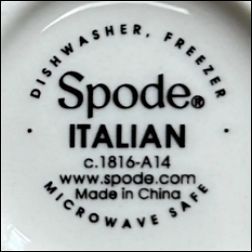
Spode
mark in the typeface 2009+ |
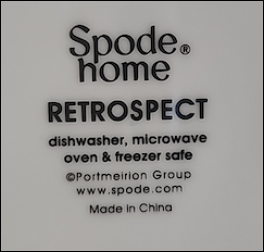
© Portmeirion Group
short lived mark
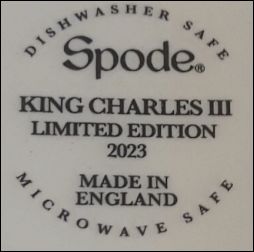
Spode ®
King Charles III
Limited Edition
2023
Made in England
|
(photo acknowledgement: |
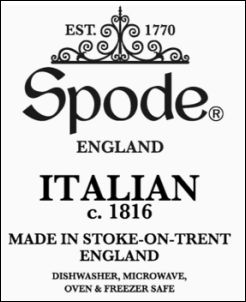 Est. 1770 Spode ® England Italian c.1816 Made in Stoke-on-Trent England |
photo: 2009 |
|
In June 2025 a new logo & backstamp was launched - the mark incorporates the scroll sitting atop the sign to the entrance to the original Spode works in Church Street, Stoke. The "Made in Stoke-on-Trent" mark will be used first on a limited-edition mug in Spode’s best-selling ‘Blue Italian’ range before starting to transition onto key products during the second half of the 2025.
|
Questions, comments, contributions? email: Steve Birks
|
Copeland, Robert (1993) 'Spode & Copeland Marks and other relevant Intelligence' Studio Vista, London.
|
|
Page created 11 October 2025 |